Couchsurfing-Themed ESL Curriculum
Tuesday, March 20th, 2012 in: Miscellany
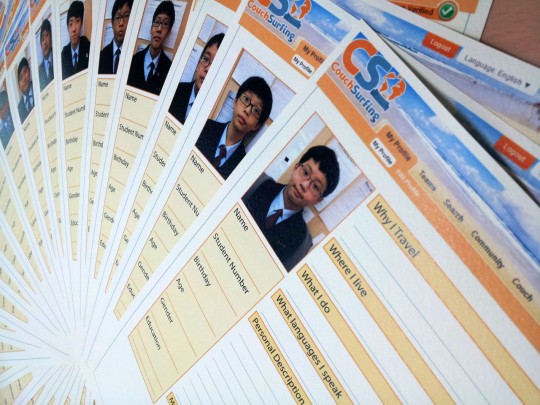
The Impetus
As an English teacher in Korea, there are many things that I find myself motivated to work on. I have a laundry list of projects to which I’ve been dedicating time, including my “deskwarming” time at work. The only thing I haven’t been too motivated to further is my teaching itself. Indeed, it seems common for teachers to whittle away their deskwarming hours goofing off on the internet, sleeping, or working on their own personal projects. That’s not to say that these are a waste or even misuse of our time–we’re just taking the cue from our Korean counterparts–but the complete absence of planning from my “lesson planning time” has struck me, and I’ve been pondering this discrepancy between what my job is supposed to be and what I actually do at work. In a stroke of irony, I’ve been having this crisis of professional identity whilst sitting at my desk.
As a designer, I feel like I’m wasting my time if I’m not doing something remotely creative, and as such, my year as a teacher almost feels like a lapse in employment as far as my professional CV is concerned. Tired of thinking about my job this way, I decided to turn it into a design challenge. I was talking to my coworker about our plans for the semester, and before I knew what I was saying I had formulated an entire themed lesson plan incorporating the text books and practical, relevant, situational English into the lessons. With just a little motivation, I’d set myself on a new exciting course that will make the most of my remaining time in Korea as an English teacher.
The Concept
The concept started with a simple question: When will our students use English in the real world? The answer is, of course, when they’re talking to foreigners: either travelers to their cities, or when they themselves visit foreign lands. I had been considering a travel-themed curriculum since I first started teaching English, but once I thought of using the Couchsurfing concept, everything seemed to fall into place.
Couchsurfing opens the students up to several different ways to study and interact. and gives the students a chance to teach each other about a new place using the English they’ve been learning. It lets them practice the kind of English they’ll most likely be using someday, and hopefully, it’ll expand their perspective on the world a little bit and make them a little more wordly. The project is broken into segments to keep the students from getting overwhelmed or bored. Our school wants us to teach a standard book lesson every other week, so the idea is to use the Couchsurfing project to reinforce the grammar and vocabulary they learn from their textbook lessons. The real beauty of the CS project is that once you get the ball rolling, the lessons can be adapted and themed to reinforce whatever the kids are learning. The project can also be expanded to suit just about any level of difficulty; my own ideas on alterations and variations are at the end of this article.
What’s more, this project could easily be translated to be used by teachers of other languages. It can even be used for young native speakers; I can see this as a “my first research project” for elementary-age children. The real key to its success lies not within the materials I’ve developed or even the idea itself, but rather in the way the project is presented to the students.
The Project, So Far
The first semester is progressing well enough, but there’s definitely trial and error throughout each step. The most important lesson for me, as the facilitator of the project, is to curb my own enthusiasm and avoid explaining my plans to the students, as it’s too overwhelming to take in at once. The first classes of the week gets a real earful and turns glassy-eyed, but by the end of the week I have the kids engaged and excited about the small tasks I’ve laid before them. It’s important to trust that the lessons build upon one another, making a foundation for greater understanding as the project progresses.
Please remember, this curriculum is still being developed and tested. If you wish to try this curriculum in your class, I only ask that you contact me and let me know how it’s going, either as a comment to this post or an e-mail (contact information under “Stalk Me” in the menu).
If you’re interested in the idea but think this is way too much effort to prep the students, or if you don’t have confidence in their ability to complete their research homework, I’ve included a variation at the bottom that may give you a good idea.
Step 1: Introduction
The first class of the new year is spent getting to know the new students, and this means going over introductions. This seems like an obvious thing for a regular class, but it’s also practice for future role play, when the students will be “surfing” with each other, they’ll have to introduce their personae to each other. I’ve created handouts that prompt students with introduction questions, and the last question on the paper is to name one city in any foreign country they want to travel to. Little do they know, this is the first step of their semester-long project.
Step 2: Research – Making a City Profile
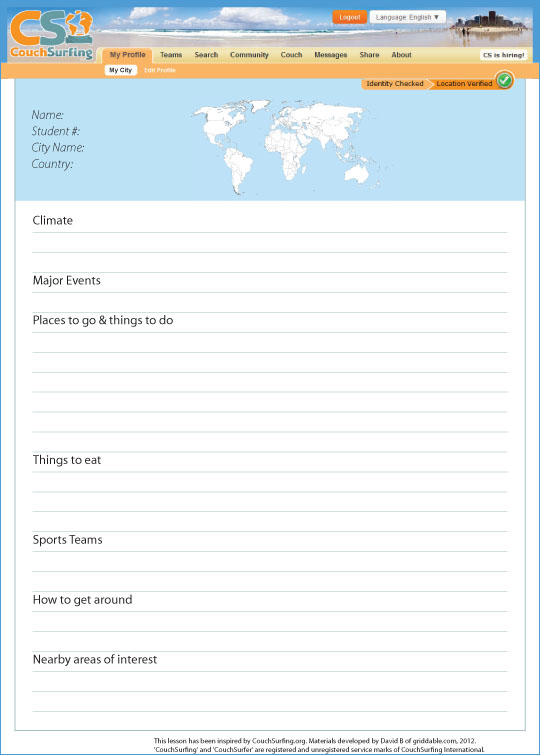
Now that the students have named their cities of choice, it’s time to learn about their new “hometowns.” First, write out on the board everyone’s cities, then have a rock-paper-scissors tournament in case there are any duplicates, so everyone has their own city. Without telling them where this is all going, give them the City Profile handout, and tell them they’ll be researching their city as homework. When they’re done groaning, assure them it’s not that much work, and launch into a detailed explanation for what kind of information they’ll need to find and record on the handout. Prompting heavily and using the whiteboard as an aid, illustrate the key information we need when we travel to a new place. It’s possible they’ve never had a research project like this before, so some extra time may be necessary to ensure they understand the concept of research itself. This lesson may seem like you’re spending an entire class explaining a homework assignment, but it’s vital to the progression of the project that the students understand what they need to do, or else they will already get overwhelmed. Use lots of examples and try to extract understanding from them naturally; feed them the information only as a last resort. This is a good way to practice prompting in a variety of ways. At the end of the class, line the kids up at the door and take passport-style photos of them for their “user profile” handouts, to come in a later class. If students ask why you’re taking photos, don’t go into details. Some time in the following class may be dedicated to reviewing the research they’ve done and helping them if they had trouble.
Step 3: Making a User Profile
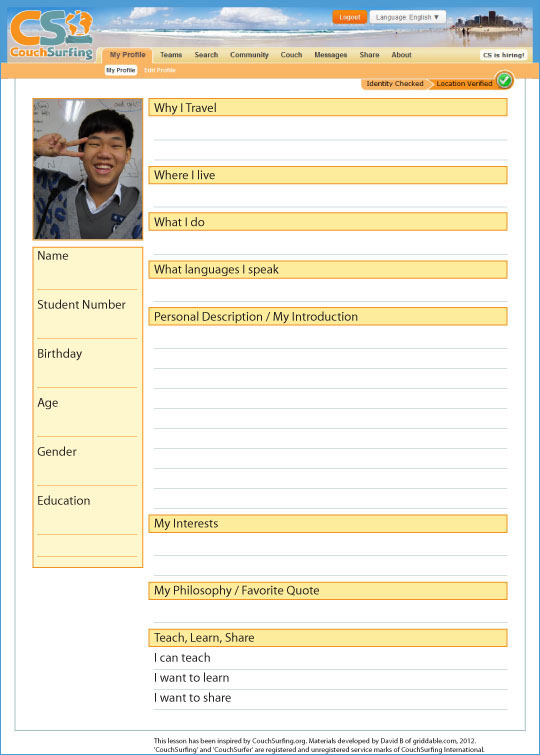
Now that the students have learned about their own cities, they are ready to be introduced to Couchsurfing. After showing a couple short videos about the concept and prompting them to ensure they understand, they are given the user profile handout, and the option to either keep their own identity or adopt a fictional persona that lives in that city. They fill in the profiles either in class or as homework, as needed.
Step 4: Ready to Surf!
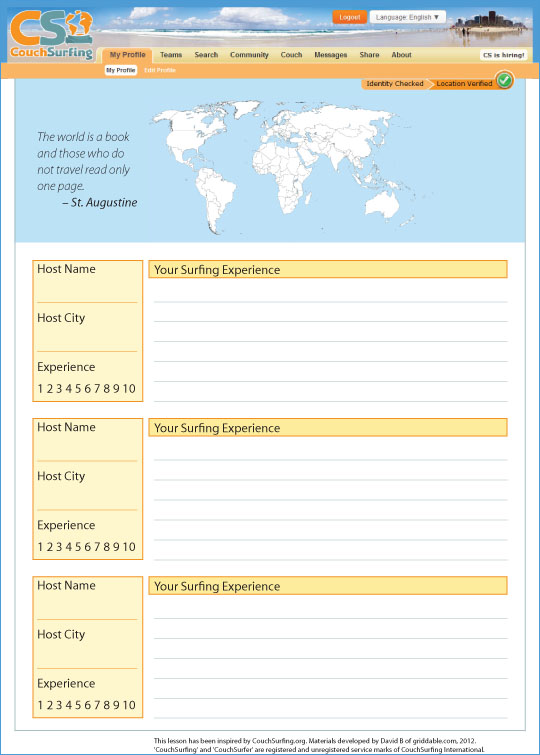
Using a game as a pretense, divide the class into two teams. Use the game’s results to choose which team is hosting and which team is surfing first. You can either let surfers choose their hosts based on where they want to travel, providing mini-games to establish who picks their host first, or if time is limited, just have them draw straws or assign them their hosts at random.
Surfing sessions are broken into a few parts, which become roleplays acted out by the students. Greetings and introductions come first, then the students need to agree on what to do together in the city. The host teaches the surfing the relevant details, then they have to record their surfing experience on a separate handout called “user feedback.” You can either just have the surfers write feedback about their experience, or you can have the hosts write as well, depending on how advanced the kids are.
Step 5: Switch Places!
To make sure everyone gets a chance to host and travel, either rotate the groups between hosting and surfing every other class, or do it as a block of several classes. You can arrange this in a variety of ways, or even give students a chance to choose with whom they’ll be surfing.
Step 6: Reflections
This can take a lot of forms, and it all depends on how your students perform.
If your students are higher level, you can…
- have them keep a travel journal about their journeys, then present one or several entries to the class as a speech
- have them come up with fictional stories, spicing up their surfing experiences. Have them make up good and bad scenarios, either keeping it realistic or let their imaginations run wild
- have them look up more detailed information in the research phase than mere tourist information, such as historical figures and environmental issues, for more interesting exchange between hosts and surfers
- hold debates with either fun or serious topics regarding life in the various cities, or life on the road (ie what are the most important environmental issues? Is it a good idea to hitchhike? Is couchsurfing safe? etc)
If they are less advanced, you can…
- have them make postcards to send “home” from their travels, talking about their experience couchsurfing
- have them pick and present their favorite city they surfed to, and why
- have them write scripts for certain situations and act them out in front of the class
The Files
Here are the files I’ve put together for my kids so far. I’ve received permission from Couchsurfing.org to use their imagery. You are welcome to use them as long as you leave the footer intact, and do not use this curriculum or these files for any kind of commercial or financial gain. As I said, the concept can be expanded or
[download id=”7565″]
The city profile, once students have chosen their new hometowns. An alternate version with historical figures and environmental issues can be found here
[download id=”7567″]
Student profiles. This project is designed to be conducted completely on paper, but digital aids can be used, like classroom wikis.
[download id=”7569″]
Surfing experience and feedback.
[download id=”7571″]
Hosting experience (optional).
Update: New variation for less advanced students and lower-committment!
If you don’t think your kids will grasp the research portion of the project, or if you can’t trust them to actually do their homework, you can skip the City Profile and even the Student profile sections, and make cue cards for all the different cities, and have students pick them or assign them at random for the activities. This is a more simple way to provide them with a context for their English practice and provides them with variation so they won’t be repeating the same thing, but I feel that it’s better for more capable students to be responsible for finding the information themselves. Doing all the research yourself means lots more prep, and you’re sort of doing their homework for them.
A potential way to bring more creativity back into the activity is to also create fictional profiles yourself and distribute them along with the city profiles. That way, when the kids interact, there is more of a roleplay element. Both the city profile sheets and profile sheets could be useful for a variety of activities beyond the scope of couchsurfing alone.
Update 2: Incorporating web-tech into the project with student-managed wikis
My coworker, who is testing this project with his advanced 1st graders is mostly forgoing the printed materials in favor of assigning the work in a web-based wikispace he’s created, where each student is given a login, and allowed to edit their own profile with surfing experiences and final reflections to be filled in as the project progresses. It’s also a work in progress but students are starting to fill out the information. You can see that by going to http://shinilcouchsurfingproject.wikispaces.com/

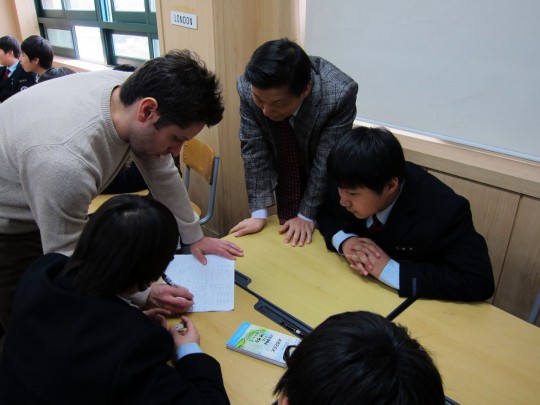







Leave a Reply